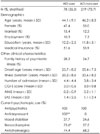1. Buckley PF, Miller BJ, Lehrer DS, Castle DJ. Psychiatric comorbidities and schizophrenia. Schizophr Bull. 2009; 35:383–402.

2. Hausmann A, Fleischhacker WW. Differential diagnosis of depressed mood in patients with schizophrenia: a diagnostic algorithm based on a review. Acta Psychiatr Scand. 2002; 106:83–96.

3. Mao YM, Zhang MD. Augmentation with antidepressants in schizophrenia treatment: benefit or risk. Neuropsychiatr Dis Treat. 2015; 11:701–713.
4. Hirsch SR, Jolley AG, Barnes TR, Liddle PF, Curson DA, Patel A, et al. Dysphoric and depressive symptoms in chronic schizophrenia. Schizophr Res. 1989; 2:259–264.

5. Koreen AR, Siris SG, Chakos M, Alvir J, Mayerhoff D, Lieberman J. Depression in first-episode schizophrenia. Am J Psychiatry. 1993; 150:1643–1648.
6. Ritsner M, Kurs R, Gibel A, Hirschmann S, Shinkarenko E, Ratner Y. Predictors of quality of life in major psychoses: a naturalistic follow-up study. J Clin Psychiatry. 2003; 64:308–315.
7. Jeong J, Won S, Chang S. Prevalence and predictors of depressive symptoms among the inpatients with schizophrenia. J Korean Soc Biol Ther Psychiatry. 2011; 17:121–130.
8. Jeon MS, KIm YS. A study of depressive symptoms in schizophrenia. J Korean Neuropsychiatr Assoc. 1981; 20:84–93.
9. Häfner H, Löffler W, Maurer K, Hambrecht M, an der Heiden W. Depression, negative symptoms, social stagnation and social decline in the early course of schizophrenia. Acta Psychiatr Scand. 1999; 100:105–118.

10. Birchwood M, Iqbal Z, Upthegrove R. Psychological pathways to depression in schizophrenia: studies in acute psychosis, post psychotic depression and auditory hallucinations. Eur Arch Psychiatry Clin Neurosci. 2005; 255:202–212.

11. Micallef J, Fakra E, Blin O. [Use of antidepressant drugs in schizophrenic patients with depression]. Encephale. 2006; 32(2 Pt 1):263–269.
12. Jin H, Zisook S, Palmer BW, Patterson TL, Heaton RK, Jeste DV. Association of depressive symptoms with worse functioning in schizophrenia: a study in older outpatients. J Clin Psychiatry. 2001; 62:797–803.

13. Conley RR, Ascher-Svanum H, Zhu B, Faries DE, Kinon BJ. The burden of depressive symptoms in the long-term treatment of patients with schizophrenia. Schizophr Res. 2007; 90:186–197.

14. Kay SR, Sevy S. Pyramidical model of schizophrenia. Schizophr Bull. 1990; 16:537–545.

15. Siris SG. Treating ‘depression’ in patients with schizophrenia: a thorough differential diagnosis determines the best treatment approach. Current Psychiatry. 2012; 11:35–39.
16. Lehman AF, Lieberman JA, Dixon LB, McGlashan TH, Miller AL, Perkins DO, et al. Practice guideline for the treatment of patients with schizophrenia, second edition. Am J Psychiatry. 2004; 161:2 Suppl. 1–56.
17. Whitehead C, Moss S, Cardno A, Lewis G. Antidepressants for the treatment of depression in people with schizophrenia: a systematic review. Psychol Med. 2003; 33:589–599.

18. Farahani A, Correll CU. Are antipsychotics or antidepressants needed for psychotic depression? A systematic review and meta-analysis of trials comparing antidepressant or antipsychotic monotherapy with combination treatment. J Clin Psychiatry. 2012; 73:486–496.
19. Buchanan RW, Kreyenbuhl J, Zito JM, Lehman A. Relationship of the use of adjunctive pharmacological agents to symptoms and level of function in schizophrenia. Am J Psychiatry. 2002; 159:1035–1043.

20. Lehman AF, Steinwachs DM. Patterns of usual care for schizophrenia: initial results from the Schizophrenia Patient Outcomes Research Team (PORT) Client Survey. Schizophr Bull. 1998; 24:11–20. discussion 20-32.

21. Xiang YT, Ungvari GS, Wang CY, Si TM, Lee EH, Chiu HF, et al. Adjunctive antidepressant prescriptions for hospitalized patients with schizophrenia in Asia (2001-2009). Asia Pac Psychiatry. 2013; 5:E81–E87.

22. American Psychiatric Association. Diagnostic and Statistical Manual of Mental Disorders: DSM-IV-TR. 4th ed. text revision. Washington, DC: American Psychiatric Association;2000.
23. Guy W. ECDEU assessment manual for psychopharmacology. Rockville, MD: NIMH Psychopharmacology Research Branch;1976.
24. Overall JE, Beller SA. The Brief Psychiatric Rating Scale (BPRS) in geropsychiatric research: I. Factor structure on an inpatient unit. J Gerontol. 1984; 39:187–193.

25. Shafer A. Meta-analysis of the brief psychiatric rating scale factor structure. Psychol Assess. 2005; 17:324–335.

26. Simpson GM, Angus JW. A rating scale for extrapyramidal side effects. Acta Psychiatr Scand Suppl. 1970; 212:11–19.

27. Munetz MR, Benjamin S. How to examine patients using the Abnormal Involuntary Movement Scale. Hosp Community Psychiatry. 1988; 39:1172–1177.

28. Bianchi S, Bianchini E, Scanavacca P. Use of antipsychotic and antidepressant within the Psychiatric Disease Centre, Regional Health Service of Ferrara. BMC Clin Pharmacol. 2011; 11:21.

29. Chakos MH, Glick ID, Miller AL, Hamner MB, Miller DD, Patel JK, et al. Special section on CATIE baseline data: baseline use of concomitant psychotropic medications to treat schizophrenia in the CATIE trial. Psychiatr Serv. 2006; 57:1094–1101.

30. Siris SG, Addington D, Azorin JM, Falloon IR, Gerlach J, Hirsch SR. Depression in schizophrenia: recognition and management in the USA. Schizophr Res. 2001; 47:185–197.

31. Englisch S, Morgen K, Meyer-Lindenberg A, Zink M. Risks and benefits of bupropion treatment in schizophrenia: a systematic review of the current literature. Clin Neuropharmacol. 2013; 36:203–215.
32. Stahl SM. Stahl's essential psychopharmacology: neuroscientific basis and practical applications. 4th ed. New York, NY: Cambridge University Press;2013.
33. Goldman RS, Tandon R, Liberzon I, Greden JF. Measurement of depression and negative symptoms in schizophrenia. Psychopathology. 1992; 25:49–56.

34. Addington D, Addington J, Maticka-Tyndale E. Specificity of the Calgary Depression Scale for schizophrenics. Schizophr Res. 1994; 11:239–244.

35. Reine G, Lançon C, Di Tucci S, Sapin C, Auquier P. Depression and subjective quality of life in chronic phase schizophrenic patients. Acta Psychiatr Scand. 2003; 108:297–303.







 PDF
PDF ePub
ePub Citation
Citation Print
Print



 XML Download
XML Download